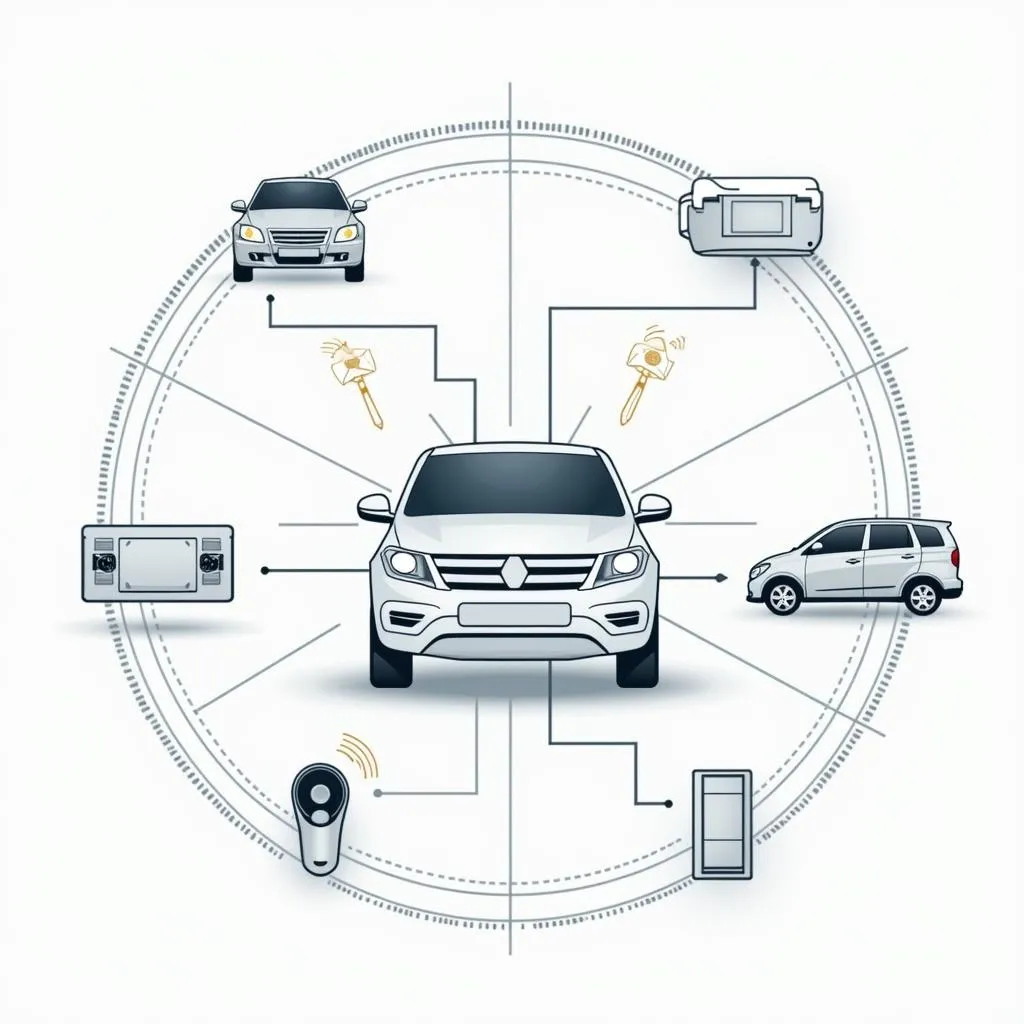Is your car’s anti-theft light blinking incessantly? This tiny red light, often shaped like a car with a key, can be a source of much frustration. While it’s designed to deter theft, it can sometimes indicate a problem with your vehicle’s security system, leaving you stranded and unsure of what to do.
This comprehensive guide delves deep into the common causes behind a flashing anti-theft light, empowering you to understand and potentially resolve the issue. We’ll also cover how to identify the problem, what tools you might need, and provide step-by-step solutions to get your car back on track.
Understanding Your Car’s Anti-Theft System
Modern vehicles are equipped with sophisticated anti-theft systems designed to prevent unauthorized access and theft. These systems utilize various components, including:
- Immobilizer System: This system prevents the engine from starting without the presence of a recognized key.
- Alarm System: Triggered by unauthorized entry attempts, the alarm system emits a loud sound and may flash the headlights.
- Keyless Entry System: Allows for convenient locking and unlocking of the vehicle using a remote control fob.
When the anti-theft system detects a potential threat or malfunction, it activates the warning light to alert the owner.
Common Causes of an Illuminated Anti-Theft Light
Here are the most common reasons why your anti-theft light might be on or flashing:
1. Weak or Dead Car Battery:
A weak battery is one of the most frequent culprits. The anti-theft system requires a stable power supply, and a low battery can disrupt its functionality.
2. Faulty Key Fob Battery:
Keyless entry systems rely on a battery-powered fob to communicate with the car. If the battery is weak or dead, the system might not recognize the signal, triggering the anti-theft light.
3. Malfunctioning Key Fob:
Beyond battery issues, the key fob itself can malfunction due to internal damage or wear and tear, leading to communication errors with the vehicle’s system.
4. Issues with the Ignition Cylinder:
The ignition cylinder reads the key’s chip to disable the immobilizer. A worn-out or damaged ignition cylinder can interfere with this process.
5. Faulty Sensors:
The anti-theft system utilizes various sensors to detect unauthorized entry. A malfunctioning door lock sensor, hood latch sensor, or impact sensor can trigger a false alarm.
6. Wiring Problems:
Loose connections, damaged wires, or corrosion in the wiring harness connected to anti-theft components can disrupt communication and trigger the warning light.
7. ECU Malfunction:
In rare cases, the Engine Control Unit (ECU), responsible for managing various vehicle systems including the anti-theft system, could malfunction, leading to unexpected behavior.
 Car anti-theft system components diagram
Car anti-theft system components diagram
Identifying the Problem
Before jumping into solutions, it’s essential to pinpoint the cause of the flashing anti-theft light. Here’s how:
- Check Your Car Battery: Start by inspecting your car battery terminals for any signs of corrosion. If you have a multimeter, check the battery voltage. A reading below 12 volts usually indicates a weak battery.
- Inspect Your Key Fob: Replace the battery in your key fob, even if it appears to be working fine. Observe if this resolves the issue. If the problem persists, there might be a problem with the key fob itself.
- Listen for Unusual Sounds: When you try to start your car, listen for any unusual clicking sounds or a complete lack of response. This could indicate a problem with the ignition cylinder or the starter.
- Observe Other Warning Lights: Take note of any other warning lights illuminated on your dashboard, as they might provide further clues about the underlying problem.
Tools You Might Need
Depending on the root cause of the problem, you may need some basic tools to troubleshoot or fix the issue:
- Multimeter
- Screwdriver set
- Wrench set
- Jumper cables
- Code reader (for diagnosing ECU issues)
 Assortment of car diagnostic tools and equipment
Assortment of car diagnostic tools and equipment
Troubleshooting and Solutions
Let’s explore potential solutions based on the common causes mentioned earlier:
1. Dead or Weak Car Battery:
- Solution: Jump-start your car using jumper cables and a working vehicle. If the anti-theft light turns off and your car starts, consider getting your battery charged or replaced.
2. Weak or Dead Key Fob Battery:
- Solution: Replace the key fob battery with a new one, ensuring it’s the correct type for your fob. Try starting your car afterward.
3. Malfunctioning Key Fob:
- Solution: If replacing the battery doesn’t work, the key fob itself may be faulty. You’ll need to get a replacement from your car dealer or a qualified automotive locksmith.
4. Issues with the Ignition Cylinder:
- Solution: Diagnosing and repairing ignition cylinder issues often require specialized tools and expertise. It’s recommended to seek professional help from a qualified mechanic or your car dealer.
5. Faulty Sensors:
- Solution: Identifying a faulty sensor can be tricky. A diagnostic scan tool can help pinpoint the problematic sensor. Once identified, the faulty sensor should be replaced.
6. Wiring Problems:
- Solution: Inspecting and repairing wiring harnesses require technical knowledge. It’s advisable to seek professional assistance from a qualified auto electrician.
7. ECU Malfunction:
- Solution: Diagnosing and addressing ECU malfunctions require advanced tools and expertise. Contact a qualified mechanic or your dealership for assistance.
FAQs:
Q: Can I drive my car with the anti-theft light on?
A: It depends. If the light is solid, you might be able to drive. However, a flashing light often indicates a more serious issue that could prevent the engine from starting or lead to unexpected problems while driving. It’s always best to address the root cause before operating the vehicle.
Q: How much does it cost to fix an anti-theft system problem?
A: The cost varies widely depending on the specific issue. A simple battery replacement might cost a few dollars, while replacing a faulty ECU could cost several hundred or even over a thousand dollars.
Q: Can I disable the anti-theft system myself?
A: It’s not recommended. Tampering with the anti-theft system can void your warranty, create security risks, and lead to further complications.
Q: What are some advanced diagnostic tools used to diagnose car problems?
A: Professional mechanics and technicians use advanced diagnostic tools, such as those offered by Cardiagtech, to accurately diagnose and troubleshoot complex car issues, including anti-theft system problems. These tools provide in-depth insights into the vehicle’s systems, allowing for efficient and effective repairs.
Need Expert Assistance?
Dealing with car trouble is never fun, especially when it involves the complexities of the anti-theft system. If you’re unable to resolve the issue on your own, remember that professional help is just a call away.
Cardiagtech offers a range of advanced diagnostic solutions to help pinpoint and address your car’s issues quickly and efficiently. Contact CARDIAGTECH today to learn more about our diagnostic products and services, and get your car back on the road safely!
